-
 Liu
Hi there! Welcome to my shop. Let me know if you have any questions.
Liu
Hi there! Welcome to my shop. Let me know if you have any questions.
Your message has exceeded the limit.

Deer-Proof Garden Fence: Keep Deer Out of Your Garden with Effective Solutions
2025-09-29 17:45:58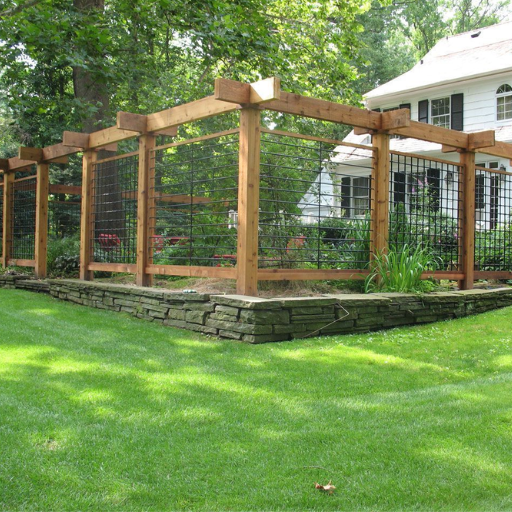
Gardening is one of the most gratifying pastimes, but it sometimes presents challenges, such as dealing with visitors like deer. This graceful animal might seem very gentle, but these animals will gorge themselves on whatever is left in the meticulously maintained garden, and get you frustrated as the plants are destroyed. Thus, an effective deer-proof fence must be erected to protect the hard work and allow the garden to grow. This article will discuss why deer are attracted to gardens, why it is essential to have the right fencing, and ways to keep them out forever. If you want to take back your garden and keep it thriving, then read on to find out how to erect the ultimate defense against the deer.Find more info now
The Importance of a Deer-Proof Garden Fence
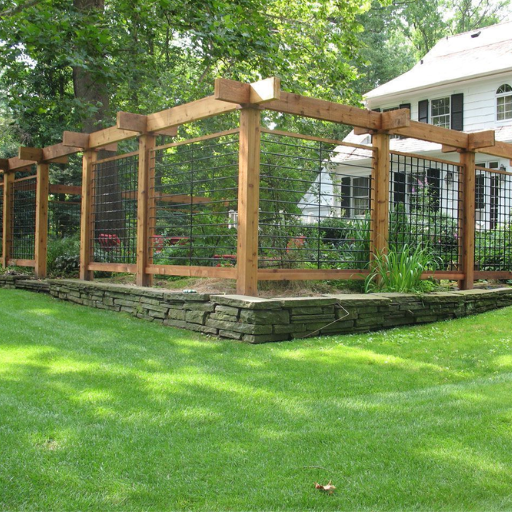
Although deer are noble and shy, when hungry, they are unmerciful enough to munch on the endless supply of flowers and plants offered in the garden, thereby putting to waste months of toil. Consequently, an almost perfect deterrent should act as a physical barrier to keep the deer away and maintain the health and productivity of the garden. For best results, a sturdy fence of an appropriate height is recommended—usually around 8 feet tall—since deers can make long jumps. A well-installed fence, being a long-term solution, will protect your gardening investment and help nurture your outdoor space.
Understanding Deer Behavior
Seasonal changes, environmental conditions, and the instinct of survival largely shape the diverse facets of deer behavior. Typically, deer are referred to as crepuscular creatures because they are active from dusk to dawn. At that time, they forage for food and water and seek shelter. Recent studies show that whitetail deer consume as much as eight pounds of vegetation each day, which is why garden plants and crops are often prime foraging targets.
Thus, deer adjust their diet according to the availability of resources. For example, from spring to summer, they prefer fresh greenery, such as grasses, flowering plants, and fruits, whereas in winter, they tend to utilize woody vegetation, including twigs and bark. This particular piece of behavior insight underlines the reason why deer activity in gardens is often greater during the warm seasons.
Moreover, their keen sense of smell, coupled with sensitive hearing skills, allows them to detect the approach of a predator or a human from great distances. It has been stated that they can pick up a scent about 1,000 times better than humans can. Regarding the protection of one's garden, this is surely interesting information to keep in mind, as any scented repellants or even quiet behavior nearby may be influencing the deer.
The population dynamics of deer significantly impact their interactions with the human environment. According to the latest information available from wildlife management agencies, urban deer population growth over a period of decades has been greatly fed by the expansion of suburban areas into their natural habitats. This is an increase from higher encounters with humans, and thus makes the need for preventive measures, such as fencing and repellents, ever so critical.
Consequences of Deer Damage to Gardens
Damage to gardens by deer can cause significant economic and ecological impacts in various ways. Deer consume all sorts of plants, from flowers to vegetables, shrubs, to trees, thereby quite often ruining carefully tended garden areas. Based on recent figures, it is estimated that homeowners across the United States spend approximately $500 million a year on plant replacement or measures for deer deterrents. This clearly demonstrates the significant economic impact resulting from the destruction of gardens by deer.
Such overbrowsing also gives rise to ecological impacts down the road, such as reducing the diversity of flora or promoting the growth of invasive species. This imbalance, created by an overabundance of deer, tends to favor strong invasive species over native plants. Studies have demonstrated that overbrowsing sadly hinders the regeneration of the forest, which is crucial for woodland renewal through competition with tree seedlings and saplings.
The interesting aspect of the aesthetic factor is that these gardens offer both personal satisfaction and community pride. Deer damage reduces the aesthetic value, and in some cases, the depletion of flowers and nectar does cause injury to pollinator populations. Therefore, effective solutions-interleaving the use of deer-resistant plants, chemical repellents, and physical barriers-are essential to counteract the damage and retain the functionality and beauty of garden spaces.
Benefits of Installing a Deer Barrier
Protection of Plants and Crops
Deer cause the wearing away of plants, flowers, and crops with a deer barrier. Studies reveal that a garden can lose up to 50% of its vegetation yearly to deer, resulting in considerable financial or aesthetic losses.
Preservation of Local Ecosystems
Deer barriers prevent overgrazing and maintain a balanced ecosystem. They ensure that food sources needed for pollinators, birds, and other wildlife do not get exhausted, thereby supporting the biodiversity of this location.
Cost-Effective in the Long Run
The initial cost of installing a deer barrier may be viewed as somewhat high, given the savings accrued over time from reduced need for continuous replacement of plants destroyed by deer and repeated purchases of repellents.
Increase in Property Value
A well-maintained garden or landscaped area draws attention to the property. Erecting a deer-proof barrier protects your investment and sustains curb appeal that enriches property value.
Health Concerns Lessen
Deer carry ticks that can spread Lyme disease and other diseases. A barrier would reduce the chances of deer entering residential grounds, thereby reducing the exposure to ticks for humans and pets.
Types of Deer Fencing Materials
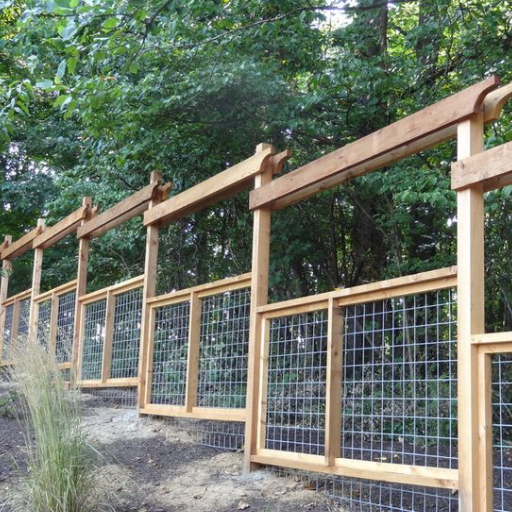
Material Type | Best For | Pros | Cons | Key Considerations |
|---|---|---|---|---|
Metal Wire Fencing | Easy installation | Durable, weather-resistant options | Needs staking, can be costly | Use galvanized or polyethylene-coated |
Polypropylene Mesh | Affordability | Lightweight, nearly invisible | Less durable, prone to damage | Choose high breaking load (800+ lbs) |
Electric Fencing | Minimal visual obstruction | Easy to install, behavior deterrent | Not physical barrier, unsafe for pets | Requires baiting for effectiveness |
Chain-Link Fence | Sturdy budget option | Durable, long-lasting | Can be unsightly, costly installation | Ensure 8 ft height for effectiveness |
Privacy Fence | Attractive, effective | Durable, blocks deer view | Expensive, obstructs view | Requires seasonal maintenance |
Woven Wire Fence
Key Features:
The height is typically between 6 and 8 feet, so that the deer may not be able to jump through the barrier.
Durability: Since the fence is made of galvanized wire, it is resistant to rust and weather deterioration, and has a lifespan that can range from 20 to 30 years with proper maintenance.
Mesh Size: These fences are available in two mesh sizes: 2" x 4" or 4" x 4". A smaller mesh size would ensure that a deer will not wrestle past or damage the fence.
Advantages:
Strength: The intermesh design provides high tensile strength, making it suitable for areas with a large deer population or heavy pressures from wildlife.
Versatility: These can be used for protecting gardens, agricultural fields, and residential plots.
Cost-Efficiency: Although the initial investment cost is moderate to high, it is offset by the longevity, resulting in low maintenance costs.
Installation Considerations:
Post Spacing: To provide optimal support and stability, the spacing between posts should be approximately 20-25 feet.
Tensioning: Wire tensioning is crucial for maintaining the integrity of the fence structure and preventing sagging.
Ground Clearance: Ensure clearance near the ground is maintained to prevent deer from being able to shove underneath.
Price Analysis:
Material costs can range from $1.50 to $4.00 per linear foot while installation may add up to $4.00 to $8.00 per linear foot. It largely depends on the terrain being worked on for this project and the materials used.
Use Cases & Effectiveness:
Woven wire fencing is used extensively in agricultural lands to protect crops or livestock, and around residential gardens to prevent wildlife intrusion. Research has shown that a fence higher than 7.5 feet is 90-100 percent effective in keeping deer out of protected areas when properly installed.
In summary, due to their strength, longevity, and effectiveness, woven wire fences offer a suitable alternative in various settings for managing deer populations.
Heavy Duty Welded Wire Fencing
A heavy welded wire fence is used in areas of increased stress and security. It is a welded wire mesh fence, meaning the wire mesh is welded using galvanized steel, which gives it maximum strength, by its nature, and also provides weathering resistance with time. It is typically used for the containment of livestock, protection of garden areas, and an anti-access fence around industrial areas.
According to recent data, heavy-duty welded wire fencing is available with a range of mesh sizes and gauges, commonly ranging from 12.5 to 16 gauge wire. Thicker gauges are better suited for heavy-duty applications, such as larger animal installations like cattle or horses. For instance, a 14-gauge welded wire fence is typically capable of withstanding a pressure of approximately 300 pounds without deformation, thereby ensuring durability over extended periods.
The galvanized coating on the welded wire fences ensures the best form of support, which can withstand rusting and corrosion even in the most severe weather conditions. Some may also be coated with PVC to provide additional durability and aesthetic appeal. For at least 15–20 years or more, a well-installed welded wire fence is a worthwhile investment to consider for long-term cost-effectiveness.
Heavy-duty welded wire fencing lends itself to the all-important versatility. It can be set up on its own or accompanied by wooden or metal posts for added strength. Current trends for decorative projects, such as trellis work or garden design, help demonstrate that it is indeed versatile beyond traditional use.
With all these qualities —durable, utilitarian, and versatile—a heavy-duty welded wire fence still remains heavily relied upon for use in residential as well as commercial settings.
Electric Fences as a Deterrent
Electric fences serve to keep away intruders, control livestock, and protect property boundaries- modern methods indeed. When touched, they emit a slight electric shock that is not lethal, forming a barrier of sorts that is both psychological and physical. This deters both human and animal offenders from attempting to breach the perimeter.
Data gathered over time shows that in recent years, electric fences have become increasingly preferred due to their high efficiency and low costs. For instance, electric fence systems have been shown to reduce livestock escapes by as much as 90% compared to traditional fences. Technological advances have transformed these systems into high-tech ones, offering options to monitor remotely, operate on solar power, and adjust voltage settings. These improvements offer the flexibility to customize fence behavior to its intent, whether that is keeping away large predators from a farm, or high-security fencing for warehouses and research centres.
Another benefit of electric fences is that their environmental impact is minimal, mainly when solar-powered energizers are used. This is because they use a very low amount of energy yet offer great performance, and they disrupt the surrounding land less during installation than their traditional counterparts. Market reports indicate a projected CAGR of approximately 7% for electric fences worldwide for the period 2023-2030, spearheaded by mounting security concerns and growing farming activities.
All in all, electric fences are technologically advanced, cost-efficient, and therefore a reliable method for various applications.
Netting and Temporary Fences
Key Point | Details |
|---|---|
Purpose | Security, crowd control, safety, privacy |
Common Uses | Construction sites, events, emergencies, animal enclosures |
Materials | Steel, aluminum, plastic, fabric, composite, wood |
Types | Chain-link, panel fencing, picket, netting, electric fencing |
Installation | Easy setup, requires stable surface, proper anchoring |
Durability | Weather-resistant, UV-stabilized, corrosion-resistant materials |
Customization | Adjustable height, color, and layout |
Advantages | Cost-effective, portable, reusable, lightweight |
Safety Features | Warning signs, proper grounding, regular inspections |
Legal Compliance | Adheres to zoning laws, safety regulations, and accessibility standards |
Step-by-Step Installation Guide for Deer-Proof Fencing
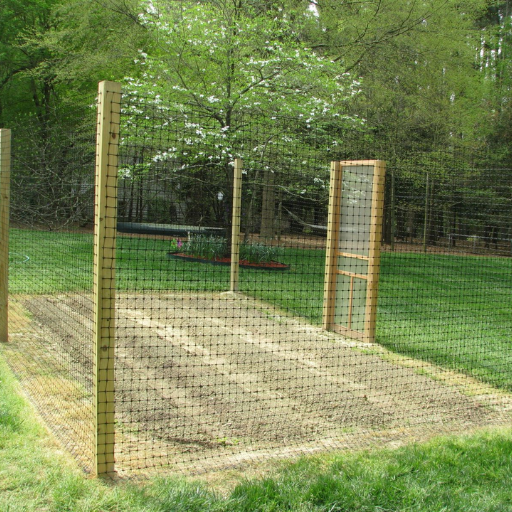
Step | Details |
|---|---|
1. Plan Fence Layout | Determine area, height, and materials needed. |
2. Check Regulations | Verify local codes for height and materials. |
3. Clear Fence Path | Remove debris, level the ground, and mark the layout. |
4. Install Posts | Space posts 8-20 feet apart, ensuring stability. |
5. Attach Mesh/Wire | Secure fencing material to posts tightly. |
6. Reinforce Corners | Add braces for stability at corners and gates. |
7. Secure Ground Base | Extend fencing below ground to prevent digging. |
8. Install Gates | Match gate height to fence, ensure secure latches. |
9. Add Tension Wires | Use tension wires to prevent sagging. |
10. Inspect Regularly | Check for damage, tighten loose wires, and repair any issues promptly. |
Planning Your Fence Line
Proper planning must be ensured to keep the deer-proof fence effective. An inspection should be conducted in the area to be protected, then the proposed fence line plotted. Consider the size of the property, terrain, and possible obstacles. Effective layout planning will prevent material waste, save time, and effectively address deer intrusion.
Deer have recently been recorded jumping up to 8 feet. Therefore, it is recommended to set fence heights between 8 and 10 feet to ensure they are truly deer-proof. Another active deterrent is a double fence, consisting of two shorter fences spaced a few feet apart, as deer tend to avoid confined spaces. This serves as an excellent deterrent in farming operations that need to secure their crops.
For improved durability, materials such as high-tensile woven wire or polypropylene mesh are recommended, combining cost efficiency with good reliability. GPS tools and mapping software will keep you on track with exact fence placement, saving you tons of time and effort out there in the field. Divide the property into several areas if it is huge. This will ease manageability and minimize installation errors. Establishing a clear French curve for the fence line will enhance the function and ensure long-term effectiveness in guarding your land from active deer.
Finally, check out your local zoning ordinances or community rules as these may define any restrictions on fence height or placement. Having this information beforehand will go a long way toward ensuring a smooth project flow.
Gathering Necessary Tools and Materials
When preparing for deer fence installation, having the right tools and materials on hand can help make the process more efficient and durable. Based on the most current recommendations, here are some essentials:
Tools:
Post Driver or Hammer – Post drivers are preferred for pushing fence posts deep into the ground for added stability. For smaller projects, a heavy hammer will suffice.
Measuring Tape – Fine measurements maintain uniformity and help avoid gaps; anything upward of 100 feet is ideally suited for large areas.
Level – A bubble or laser level comes in handy while installing the posts to keep them upright.
Wire Cutters – Heavy-duty wire cutters are required for blocking any fencing material.
Shovel or Post-hole Digger – For deeper post placements, these tools help provide stable footing.
Tensioning Tool – Used to appropriately stretch the fence wire or mesh for a secure and tight fit.
Protective Gear - Gloves, goggles, and sturdy footwear can safeguard against accidents that may occur during the installation process.
Staple Gun or Fence Clips – For affixing the fencing material to wooden posts or holding the ends in place.
Materials:
Fence Material- Choose between mesh wire, polypropylene, or high-tensile wire according to your requirement. High-tensile wire is more durable and can withstand more force than polypropylene. For example, a standard 330-foot roll of polypropylene deer fence costs approximately $150-$200 on the current market.
Fence Posts- Use strong ones, including those made out of treated wood, metal, or fiberglass. They should be spaced at least a foot apart for maximum support. Wood posts are typically set in corners because they provide support, whereas T-posts and U-posts are used to support the fence in straight lines.
Gates- Access gates that are at least as tall as the fence and made of the same material should be installed. A typical 6- to 8-foot deer fence usually requires a gate of the same height to ensure its effectiveness.
Fasteners and Ties - Weatherproofed zip ties, U-nails, or fence staples keep the fencing material securely fastened to the posts.
Marking Flags or Stakes - Before installation, marking flags or stakes should be used to mark the fence path for greater accuracy.
Other Considerations:
Fence Height: According to research, deer fences should be at least 8 ft high to deter jumping. Other options include poly-coated steel fences, which combine strength with flexibility.
Ground Stakes: To prevent digging, the fencing material should be anchored at the ground level using ground stakes on every 6- to 12-inch distance.
By obtaining these tools and materials, you can make your installation process more seamless, thereby avoiding unwanted delays and ensuring your deer fence remains functional for many years.
Installing the Fence: Best Practices
Measure and Plan Thoroughly: Measure your installation site with care. Mounting errors or misalignments can be costly if the plans do not include every conceivable corner or entry point.
Use Sturdy Posts: Set fence posts into the ground with solid support while ensuring a minimum depth of at least 2 feet for stability. Wooden posts or metal posts are good choices to maintain a long life and strong weathering qualities.
Keep Tension: The fence should be carefully stretched to prevent sagging, which could reduce resistance against deer.
Contact Ground: The bottom of the fence should lie on the ground or may be anchored with ground stakes to deter deer from climbing underneath.
Be Gap-Free: Inspect the entire perimeter of the fence, checking for any gaps or weak areas that could compromise protection from deer. Guards should be inspected periodically, checking on these areas regularly.
Maintaining Your Deer-Proof Garden Fence
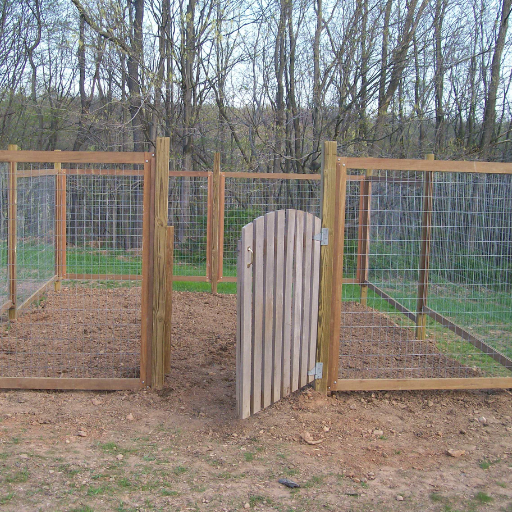
Proper maintenance of your deer-proof garden fence ensures greater longevity and higher chances of it serving its purpose. These are five steps that one should adhere to in maintaining the fence:
Inspect Regularly: Walk the entire length of the fence on a routine basis to note any damage, sagging, or wear and tear. Is there a broken wire somewhere? Were the posts somehow loosened? Are there areas in the wall where deer can step over?
Repair Damage Promptly: A prompt repair is the best first step. Replace any broken section or part that is weakened, pull up sagging sections, and nail those loose posts to keep the fence standing tall.
Clear Vegetation: Clear trees and bushes that can weigh on the fence or hide weak spots or create a path for the deer to jump over.
Reinforce Weak Areas: Strengthen weak sections by adding more wire, ground stakes, or doubling the mesh.
Monitor Seasonal Changes: Adjust your fence maintenance to seasonal conditions. An instance can be after heavy snowfall or storms when your fencing is weighed down or rendered weak; do make a point of repairing it promptly.
Follow these steps with diligence, and your deer-proof garden fence should provide lasting protection for your plants and crops throughout the year.
Regular Inspections for Damage
As a substantial investment, regular inspections are crucial for maintaining the integrity of your deer-proof garden fence. Walk around the entire fence perimeter at least once every two weeks or more often in areas with a high influx of deer activity. Check for signs of wear; even those tiny tears under your hands on the mesh would be enough to dent its effectiveness. Look also for bent or broken posts.
Studying recent instances, deer can jump up to 8 feet high or squeeze through a gap of just 6 inches. Hence, keeping the fence's recommended height of at least 8 feet is vital, and all sections should be firmly fixed with no gaps. Another thing to closely look into are weak points near gates or corners because those places will surely be tested by determined wildlife.
Environmental factors that contribute to damage must also be assessed during inspections. For example, fallen branches, heavy snow, or powerful winds could be some of the culprits. A 2023 report from a wildlife organization revealed that storms account for nearly 40% of fence damage in heavily wooded areas. Entering into repairs for these problems promptly will save you from more expensive ones later.
If regular inspections become part of your routine and damages are addressed whenever identified, your fence will always stand as a reliable barrier against deer and other invasive wildlife.
Repairs and Upkeep of Fencing Materials
Fencing requires proper upkeep to maintain its ideal condition. Immediate inspections and repairs save large expenses later and even greater inconveniences. A few key repairs and maintenance related to the fencing and all that will be discussed in detail below, to help keep your fence in the best condition:
Repairing Broken or Loose Posts
With time, erosion in soil or old age would weaken a post to be loose or cracked. Any loosened one must be secured tight or altogether removed and replaced with a new one in order to ensure the structural integrity of the fence. The industry average cost for replacing a broken wooden post is between $20 to $50, depending on materials and labor.
Replacement of Damaged Sections
Occasionally, weather or animals damage individual fence boards or panels. This may be a cheaper option where you only replace sections of the fence that are affected. For example, replacing a single wooden panel costs somewhere between $15 and $30, while repairs for vinyl or composite are more costly.
Repainting and Sealing Wooden Fences
Periodic repainting or staining is required for wooden fences to protect against moisture, sunlight, and pests. Painting or sealing must be reapplied every couple of years, usually every two to three years. The average cost of doing so is approximately $1 to $2 per square foot, including both material and labor costs.
Fixing Sagging Gates
Ground shifting and wearing out of hardware can cause gates to sag. Regular checks of hinges, latches, and gate posts should be undertaken to ensure alignment. Costs for adjusting gates and replacing hinges will include about $10-$25 for hardware but exclude labor.
Removal of Vegetation and Debris
Heavy vegetation and debris will keep the fence under pressure, thus inducing premature damage. Regularly trim back plants and clear soil or debris buildup at the fence base. Maintain clearance to avoid the risk of rot and pest infestation.
Maintenance, as described above, will reduce the loss of life inflicted on your fence and provide it with maximum service for a long time.
Keeping the Area Around the Fence Clear
Around the fence, a clear area must be maintained to prevent damage to the walls, thereby prolonging the fence's life. Overgrown vegetation, debris, and soil accumulation can trap moisture on the surface, leading to wood rot, rust, or other types of material decay. Studies exist that support the fact that fences with unrestricted airflow and no invasive plants tend to last 20% longer than those surrounded by dense overgrowth.
For shrubs and plants, trim to keep at least 1-2 feet away from the actual fence line. Removal of debris-laden leaves, grass clippings, or fallen branches is equally essential, as it prevents pests, such as termites and rodents, from nesting nearby or causing damage to the fence. Additionally, grading the soil around the fence properly to ensure water can drain away from the posts helps prevent water pooling, a common cause of structural weakening.
Cleaning and inspection of the fence area should occur regularly, ideally at least once every three months, to achieve a significant difference in fence longevity. A recent study revealed that committing just 10-15 minutes per cleaning session can help keep most homeowners out of heavy repair costs in the end. With such easy preventive measures, a fence will remain a clean, catchy view to different eyes and perform well in its intended usage.
Additional Strategies to Keep Deer from Eating Your Garden Plants
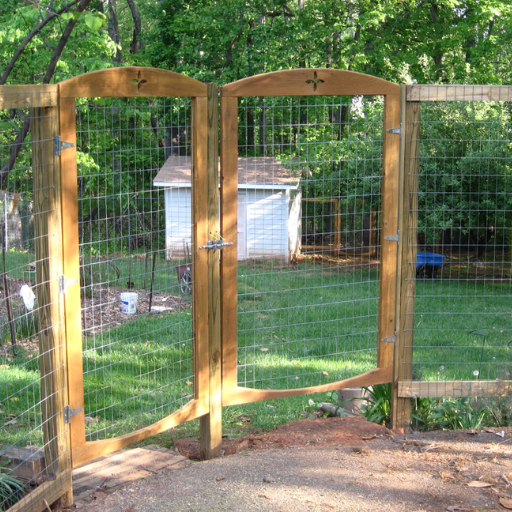
Deer are quite persistent when they want to enter a garden, but a combination of deterrents can significantly reduce cases of damage. Other proven deterrent methods include:
1. Use Deer-Resistant Plants
Planting gardens with plants that deer do not find attractive is the most environmentally friendly method of protecting your garden. Deer usually avoid plants with strong fragrances, coarse textures, or with thorns, according to some experts. Some famous deer-resistant plants are lavender, marigolds, and foxglove. Additionally, planting native plants well-adapted to your region may also deter deer.
2. Use Motion-Activated Deterrents
Modern motion-activated deterrents, such as sprinklers or ultrasonic devices, can scare deer away without harming them. In a 2022 survey, nearly 70% of participants who installed motion-activated sprinklers in their gardens reported a significant decrease in deer activity within two weeks.
3. Apply Repellents Regularly
Repellents are quite reliable in keeping deer away. Based on recent recommendations from agricultural universities, liquid or granular repellents that mimic the scent of predators are most effective for deer. It is best to apply the repellents after rain and during the growing season for continuous protection.
4. Construct Tall Fences
According to some data, deer can jump over any fence that is anything under 8 feet in height. In this case, any fence supposedly keeping deer out should be at least 8 feet in height and constructed with strong materials such as woven wire. Alternatively, attaching an angled extension would also help keep those stubborn deer out.
5. Create Physical or Visual Barriers
An obstructed view causes deer to hesitate before passing through any area. One can plant a dense hedge or put up fabric netting above their most precious plants to baffle and discourage them. However, temporarily, reflective material such as tape or pinwheels may serve as a visual deterrent because they tend to require regular repositioning.
6. Rotate Deterrents
Because deer can get used to some deterrents over time, rotating methods provides a dynamic defense. Combining repellents, fencing, and motion-activated sprinklers, for example, will keep deer guessing and together reduce the chance of habituation.
When these multi-layered approaches are put in place, deer penetration can be seriously limited, greatly benefitting the garden. Each step helps make the area less attractive to deer, allowing it to flourish.
Using Deer Repellents Effectively
Deer deterrents require a certain understanding of their working mechanism and appropriate applications, based on scientific research and expert advice. These repellents are commonly categorized as either scent-based or taste-based. Scent repellents repel their victims by emulating a predator's odor or by using ingredients that emit foul, graveyard-like smells, such as putrescent egg solids, garlic, or predator urine. Taste repellents work on the plants themselves, providing them with an unappealing taste using bitter ingredients such as capsaicin.
According to several recent studies, deer repellents are effective depending on the season and on whether alternative food sources are available. When the winter months are upon us and a natural food supply is low, deer will be less inclined to endure the bad taste or bad smell of treated plants in comparison to times when they are in abundance. A research-backed recommendation, based on a study conducted at the University of Vermont, states that repeated applications of multiple repellents can reduce plant damage by up to 52%, making it a recommended strategy for achieving long-term results.
Repellents should be applied consistently and reapplied after rainfall; unfortunately, many are rendered ineffective by water. Furthermore, changing the repellents every few weeks would prevent the deer's ability to become accustomed to one type. A garlic spray followed by a capsaicin spray is one such rotation scheme to keep the poor creatures confused.
Moreover, using repellents in conjunction with other techniques, such as a physical barrier or planting species known to be deer-resistant, would go a long way towards deterring deer from your garden, according to observations made from figures collected by Michigan State University Extension. Repellents, combined with fencing, cut damage by over 80%, thereby highlighting the necessity of an integrated approach. In using these discovered truths and methods will see better plant protection and a thriving garden throughout each season.
Companion Planting and Landscaping Techniques
The techniques of companion planting and landscaping are essential tools for cultivating a thriving, pest-resistant, and environmentally friendly garden. These strategies involve the deliberate arrangement of plants to maximize benefits, promote growth, and deter pests without resorting to chemical controls. Here are five major companion planting and landscaping tactics illustrated with some pertinent details and insights:
Grouping Plants with Similar Requirements
This technique ensures that those plants receiving similar amounts of sunlight, water, and soil needs are planted together. For instance, pairing lavender and rosemary, which grow best in well-drained soils under the sun, could enhance the growing conditions for both species.
Using Trap Crops
Trap crops are a few plants situated near the main crops to lure pests away. The practice of planting nasturtiums near cucumbers to lure aphids away from the main crop is standard. Research centers have demonstrated that trap cropping can reduce pest damage by more than 40%.
Using Nitrogen-Fixing Plants to Enhance the Soil
Plants that fix nitrogen, such as legumes like peas and beans, improve soil conditions for companion crops like corn and spinach. This natural form of soil improvement reduces fertilizer use and keeps the garden ecosystem more sustainable.
Interplanting Tall with Short Plants
By interplanting tall species, such as sunflowers, with shorter ones, such as lettuce, gardeners can create a natural microclimate. This technique provides shade, retains moisture, and helps protect sensitive plants from excessive sun exposure.
Planting Herbs as Natural Pest Deterrents
Herbs such as basil, mint, and marigold repel a whole lot of pests, including mosquitoes and aphids. Using these in a garden plan strengthens its pest resistance, biodiversity, and visual appeal.
With the implementation of these practices, gardeners encourage a more productive, resilient, and cooperative garden while lessening dependence on synthetic inputs.
Employing Dogs or Other Deterrents
Animals can act as natural deterrents to one of the culprits threatening the garden or farm. Besides certain dog breeds like Border Collies and Great Pyrenees, dogs with strong instincts toward guarding can repel wildlife such as deer, raccoons, and rabbits. In a study published in 2023 on wildlife deterrence, livestock guardian dog owners reported a 60-percent decrease in incidences of predation over the span of two years. This decline underscores the poise attributed to using a well-trained dog as an environmental defender. Other deterrent methods include the installation of motion-activated sprinklers, ultrasonic repellents, or non-toxic deterrence sprays specifically targeted toward particular species, while preserving the environment. Motion-activated sprinklers, for instance, are designed to deter deer and cats, whereas ultrasonic devices emit frequencies that are uncomfortable for certain animals but inaudible to humans. Choosing the best deterrent always depends on the nature of the target pests and tailoring the solution to each unique environmental challenge. When combined with the natural deterrent approach of dogs, a two- or three-pronged defense strategy can be created for a productive garden that repels a wide range of pests.
Frequently Asked Questions (FAQ)
What is the best fence to keep the deer out of the garden?
The best fence to keep the deer out of the garden is generally a tall fence, one that stands at a minimum of 7 feet in height. Deer can easily jump fences lower than this, which makes a tall fence an effective deterrent. Electric fences, woven wire fences, and mesh fences with high visibility are fine choices for deterring hungry deer.
How does a perimeter fence protect your garden?
A perimeter fence acts as a physical barrier, preventing deer and other animals from gaining access to your garden areas. By erecting fences around your vegetable garden or flower beds, the lethal chances of deer munching on your plants are significantly reduced. When selecting fence types, always opt for ones that stand at least 7 feet high to prevent deer from making a jump over.
Can a deer-proof garden fence also keep rabbits out?
Yes, a deer-proof garden fence can keep rabbits out if it is constructed with smaller perforations at the bottom. Using a mesh or welded wire fence will help restrict rabbits from digging under or physically squeezing through. However, ensure that the height of the fence is suitable for both deer and rabbit intrusion.
What fencing is recommended for deterring deer?
The best fencing against any sort of deer pressure is tall, sturdy fencing ideally made of welded wire or of the electric variety. This type of fence withstands every attempt by deer to jump or push through. Furthermore, double fencing would further enhance protection; however, these barriers do not have a good reputation.
How do you make a temporary fence for your garden?
A temporary fence for any garden can be made from chicken wire or black mesh, as these materials are easy to install and take down. Set up fence posts at intervals; they are a bit taller than the deer would usually jump, and attach the fencing along the posts. Temporary fencing will be a great method to protect your garden in peak deer activity seasons.
What materials are best to be used for deer-proofing the fence around the garden?
The best materials for a deer-proof garden fence are galvanized metal wire, woven wire, and electric fences. These materials offer durability in differing weather conditions, ensuring the wall serves as a formidable barrier against deer and other animals. They are resistant to rust and wear in any event, which makes it an excellent option for long term usage.
How do deer learn to avoid sure fences?
Through experience, deer can learn to avoid sure fences. If they encounter a wall that proves hard to jump or push through, they might start associating that fence with danger and thus prevent it in the future. Electric fencing, for instance, is a beneficial feature to add, as it reinforces avoidance behavior with a mild shock.
Can I use deer repellent sprays in conjunction with a fence?
Yes, applying deer repellent sprays along with a fence can grant an extra layer of protection to your garden. While a fence serves as a deterrent from physically entering the garden, repellent sprays keep deer away by discouraging them from approaching the plants. Such dual methodology proves quite effective in areas with an immense deer population.
What is the depth perception of deer, and how does it affect their jumping ability?
Deer have poor depth perception, so they are unable to judge the height of obstacles such as fences. Therefore, when a wall reaches a certain height, deer find it too much to overcome and do not even choose to try to jump over it. If you build your fence at least 7 feet high, you can take advantage of this aspect of deer ecology to keep them out of your garden
Tags: deer proof garden fence


